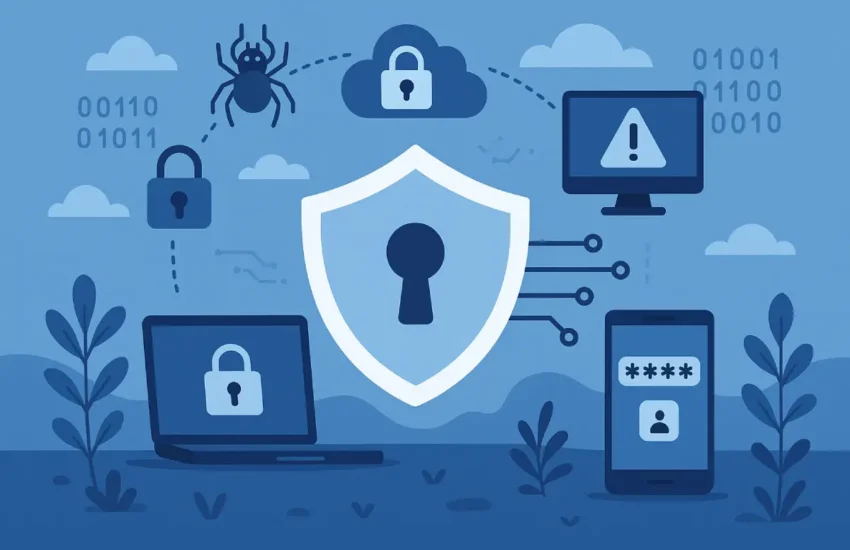Firewall Options for Network Protection Monitoring and Threat Prevention
Ensuring the safety and continuity of digital environments requires effective firewall options. As businesses grow more dependent on online technologies, they face advanced threats that can exploit vulnerabilities within their infrastructure. Securing your network takes more than just a single layer of defense. It requires constant monitoring, ongoing threat mitigation strategies, and an approach that evolves with new attack vectors.
Contents
- 1 Why Firewalls Matter in Cybersecurity
- 2 Layered Approaches to Attack Vectors
- 3 Key Considerations for Access Control and VPN
- 4 Harnessing Cloud Security for Greater Scalability
- 5 Practical Tips for Endpoint Protection and Malware Defense
- 6 Bolstering Network Monitoring with Firewalls
- 7 Staying Ahead with Evolving Firewall Options
Why Firewalls Matter in Cybersecurity
Firewalls act as gatekeepers between your internal systems and outside networks. They filter incoming and outgoing traffic based on specific rules, preventing malicious data packets from slipping through unnoticed. This role is fundamental to maintaining strong cybersecurity because it deters external intruders while giving you better control over what leaves your network.
Many organizations pair firewalls with endpoint protection measures to reduce the risk of malware protection failures. By doing so, they strengthen their overall security protocols and make the infiltration process much more difficult for attackers. Firewalls have evolved to provide advanced features such as intrusion detection, threat intelligence data, and even built-in spyware removal capabilities in some cases, though dedicated tools often supplement these functions more effectively.
Evaluating Threat Mitigation Techniques
Threat mitigation starts with understanding the nature of attack vectors you face. Conventional hackers might attempt to deploy viruses or malware, hoping to find gaps in your firewall settings. Meanwhile, more sophisticated adversaries could rely on DDoS mitigation tactics or social engineering strategies like phishing prevention. Keeping firewall rules updated and tailored to your environment goes far in reducing the success rate of such attacks.
A dynamic, well-configured firewall can handle large traffic volumes in real time, sifting through potential threats before they become breaches. Through features like advanced logging and security information and event management solutions, you can gather valuable insights on suspicious activity. This information, combined with robust incident response protocols, ensures you aren’t left playing catch-up when confronted with new exploits.
Layered Approaches to Attack Vectors
Modern threats often come in multiple stages, requiring a layered security strategy that integrates firewalls with other critical defenses. Intrusion detection systems enable you to spot irregular network traffic that may bypass traditional filtering. Coupled with antivirus software, this forms a comprehensive shield designed to detect anomalies and execute virus removal when needed.
Data encryption plays a pivotal role in protecting sensitive information at rest and in transit. Whether you’re swapping files internally or sending them through secure sockets layer connections, encrypted transmissions reduce the chance of exposure if intercepted. Fostering robust identity management procedures within your organization adds another layer of security, ensuring that users and administrators alike follow proper authentication guidelines.
Intrusion Detection and Endpoint Security
Intrusion detection helps you spot unusual behavior early. When blended with firewall policies, this technology makes it harder for attackers to get a foothold in your network. You can track indicators like unexpected administrative logins or suspicious file transfers, triggering alerts whenever conditions meet certain risk thresholds.
Endpoint security complements intrusion detection by shielding individual devices in your network from being used as stepping-stones for larger breaches. Through configuration management and continuous monitoring, endpoints remain more resistant to tampering. This synergy strengthens your overall network security posture.
Key Considerations for Access Control and VPN
Controlling who comes and goes within your network is crucial. Proper access control frameworks assign different permission levels to various user profiles, ensuring data breach prevention by letting only authorized individuals enter restricted zones. When integrated with firewall policies, access control can reduce the risk of rogue devices or unauthorized logins causing havoc.
Securing remote connections through a VPN supports the confidentiality of transferring data across public or untrusted networks. Firewalls usually complement this layer by ensuring protected tunnels remain immune to intrusions. By combining VPN protocols with encryption standards, you drastically reduce the likelihood of unauthorized interception. In larger environments, paying attention to wireless security configurations ensures that remote employees, branch offices, or guests connect safely without exposing critical assets to malicious visitors.
Maintaining Security Patches and Regular Risk Assessment
Timely application of security patches is one of the simplest and most effective ways to strengthen your firewall’s performance. These updates often include important fixes against newly discovered threats, plugging vulnerabilities that attackers exploit. Alongside frequent patching, periodic risk assessment ensures you stay informed of evolving risks and maintain readiness for newly identified weaknesses.
Penetration testing simulates real-world attacks, allowing you to gauge how well your firewall stands up to attempts at intrusion. Observing the results often highlights overlooked holes in your incident response protocols, data encryption strategies, or firewall configurations, guiding you to reinforce weak spots. Organizations that follow this practice typically respond faster and more effectively to a genuine attack.
Harnessing Cloud Security for Greater Scalability
Shifting resources to the cloud has introduced new avenues for network protection. Cloud-based firewalls scale quickly, adapting to fluctuating traffic demands while maintaining consistent threat mitigation standards. This flexibility can be particularly beneficial for businesses experiencing seasonal spikes, as they won’t need substantial hardware investments to handle increased loads.
Cloud security approaches also integrate well with security awareness training programs. Virtual dashboards enable easier deployment of real-time alerts, prompting swift remediation whenever anomalies appear. By pairing your cloud firewall with network monitoring solutions, you enhance visibility across distributed systems, which is especially helpful for companies that rely on multiple data centers or hybrid setups.
Importance of Security Information and Event Management
Security information and event management connects logs and data points from across your infrastructure, including firewalls, intrusion detection tools, and malicious activity trackers. By collecting and correllating these entries, it helps your team spot hidden patterns that might indicate a gradual attack taking shape. When an event flags, automated triggers can isolate compromised segments to stop potential spread.
Integrating SIEM solutions with your firewall ensures that unrecognized traffic is flagged quickly. Over time, these analytics refine themselves, improving their ability to differentiate between routine processes and suspicious events. Coupled with timely identity management processes, this synergy provides the clarity needed to fine-tune firewall guidelines and keep networks secure.
Practical Tips for Endpoint Protection and Malware Defense
Validating the integrity of connected devices is crucial for consistent malware protection. Encouraging best practices, such as installing antivirus software and regularly scanning for spyware removal, helps keep endpoints free from compromised software. In enterprise settings, setting clear security policies ensures employees and contractors alike follow procedures that minimize the risk of contamination.
Well-structured firewall rules act as the outer barrier against malicious traffic, but they rely on well-guarded endpoints to prevent internal attacks as well. Endpoints are often exploited as attack vectors if they’re not properly patched. By combining robust patch management with layered mechanisms like access control and data encryption, you create an interlocking system that’s harder for attackers to crack.
Security Awareness Training and Phishing Prevention
Human error remains a top cause of data breaches. Training personnel on phishing prevention techniques reduces the chance of clicking a dangerous link or sharing sensitive credentials. Setting up mock scenarios helps reinforce secure habits, and it’s a good opportunity to stress the importance of verifying suspicious emails before reacting to them.
When users combine their training with strong firewall protocols, they become a deterrent rather than a vulnerability. A workforce that actively scrutinizes threats steers attackers away, as they’re more likely to meet barriers at multiple points. Over time, cultivating a knowledgeable user base can reduce incident response pressure by catching issues early.
Bolstering Network Monitoring with Firewalls
Continuous network monitoring compliments firewalls by providing insights into how data moves internally. This approach can detect subtle anomalies, such as unauthorized data transfers or sudden spikes in outbound traffic. The earlier a potential breach is identified, the less damage it can inflict, making real-time monitoring an invaluable ally for network security strategies.
Coupling network monitoring with advanced firewall policies helps automate blocking actions. If suspicious behavior is detected, you can limit access or quarantine the affected nodes. This blend of proactive and reactive methods underscores the value of having an adaptive firewall that leverages logs, analytics, and threat intelligence to make quick decisions.
Staying Ahead with Evolving Firewall Options
Technology advances continually, and so do the tactics of cybercriminals. Firewalls now come equipped with application-level filtering capabilities, advanced intrusion analysis, and even machine learning algorithms that spot anomalies on the fly. As part of your larger cybersecurity strategy, consider solutions that can integrate seamlessly with other security layers, such as penetration testing suites, security patches automation, and data breach prevention protocols.
Regularly updating your firewall technology is as important as installing it in the first place. A product that performed well a few years ago may no longer suffice against modern threats like multi-vector attacks. By evaluating improvements in hardware-based firewalls, virtual counterparts, and cloud-native solutions, you can tailor your system to keep pace with the shifting threat landscape. And with risk assessment exercises, you can validate that your decisions align with actual organizational needs.
Investing in the right firewall is an ongoing process. You want a solution adaptable to the unique challenges of your environment, whether that’s large-scale cloud deployments, remote workforces, or specialized compliance requirements. Staying informed of new releases and upgrading when necessary will keep your networks fortified against emerging exploits, ensuring the continued resilience of your critical assets and essential data.



